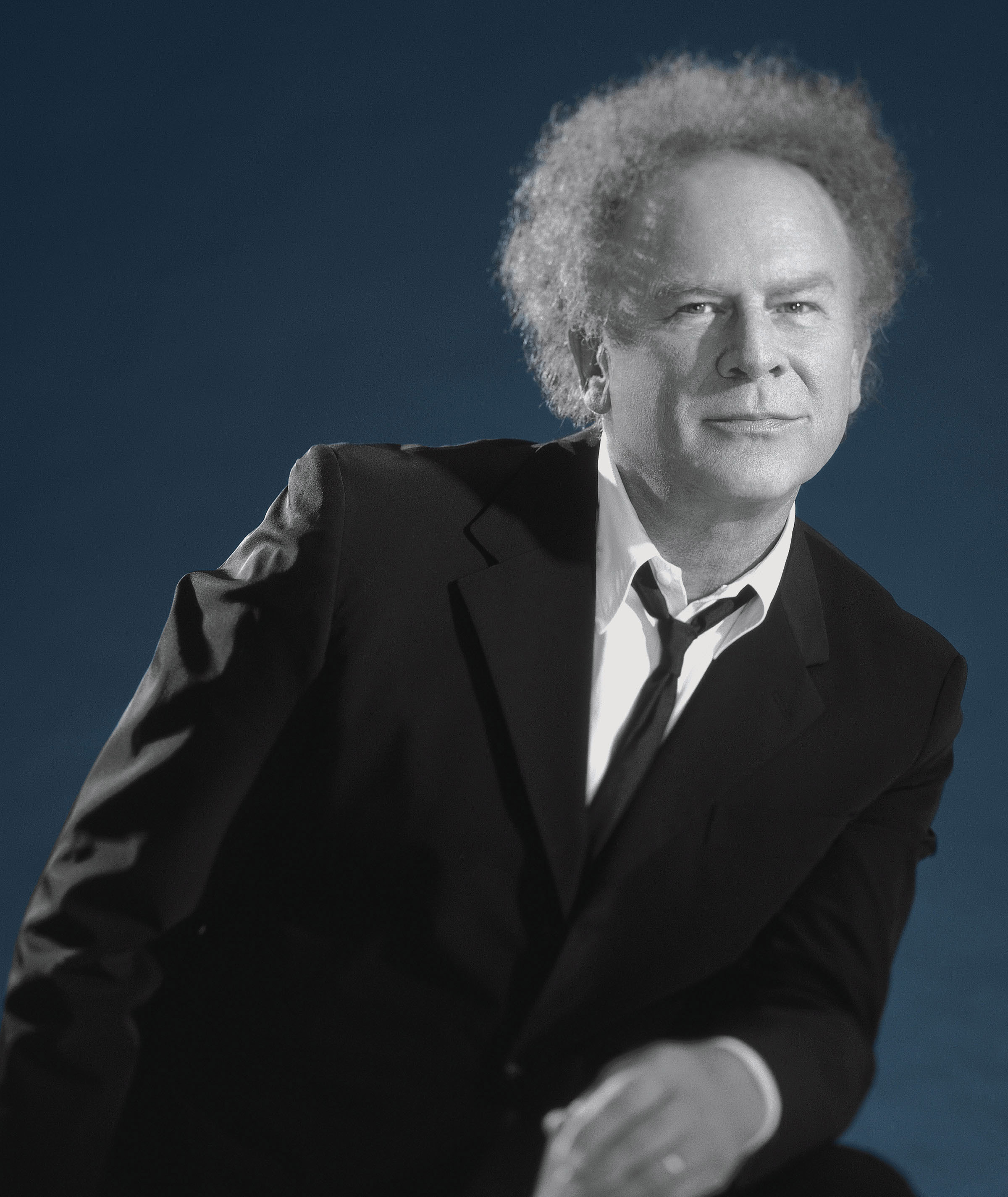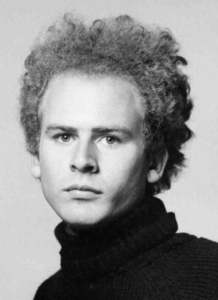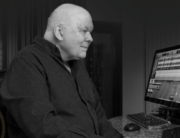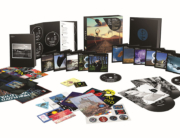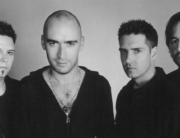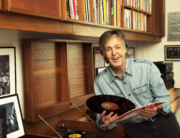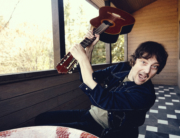BY MIKE METTLER – NOVEMBER 5, 2015
There was a time Art Garfunkel thought he may never sing again, not long after he returned from a Simon & Garfunkel tour in the Far East in 2010 and promptly lost his voice. “You go into a terrible depression. What am I going to do? Who am I? If I don’t sing, I’m not Artie anymore,” Garfunkel recalls of those dark days.
Gradually, with patience, practice, and time, his voice returned to full strength. “I got it back, yes, and that’s the full level of triumph,” he says enthusiastically. “I feel so grateful to God. Now I just aspire to be a valid artist.”
For a story that recently posted on Palm Springs Life, I called Garfunkel at his New York City residence to discuss his early days as a singer, how he got his voice back, and whether he’d play live with a certain Old Friend again. We talked about much more than that during our never-dangling conversation, of course. Herewith, the full balance of our interview is presented exclusively on The SoundBard, wherein we discuss respecting both the act and the art of listening, which Simon & Garfunkel song he considers to have benefited the most from their in-studio meticulousness, and what he’d like to do next.
Mike Mettler: I’m sure you’re well aware that we audiophiles consider much of your recorded work to be sound-quality benchmarks, and we often use it to test gear to see how well it handles vocal quality.
Art Garfunkel: We were good, weren’t we? Make sure you credit Roy Halee, the third member of Simon & Garfunkel. [Halee was the producer/engineer on all of Simon & Garfunkel’s studio albums.]
Mettler: You’re responsible for a lot of that production work as well, which I think sometimes gets overlooked, doesn’t it?
Garfunkel: Do I think that’s a fair thing to say? Yeah.

The S&G Complete Albums Collection, in its full CD-array glory. (The vinyl box set feels even groovier.)
Mettler: You must be pleased with
The Complete Albums Collection
(Columbia/Legacy) that recently came out on CD, download, and vinyl, I’ll bet.
Garfunkel: I’m thrilled! When Sony sent up those boxes, the six vinyl records – I thought it was such a neat package. To hold in your hand that 14-inch by 14-inch square and those six vinyl records, it made me go, “Oh, there’s the baby! That’s what we made!” And all of that hard, tireless work – that’s what I stayed in the studio way after midnight, fixing and fussing and polishing with Roy. “These are the babies!”
Mettler: It’s the benchmark for what sounds right on vinyl, and in hi-res.
Garfunkel: I’ll take the compliment. We certainly worked tirelessly to get it right. We were nuts. When you lose your proper sense of things, you go crazy in trying to get it right. When you want the mark of being a perfectionist, it turns out you get great stuff that way.
Mettler: Is there one example of something you went for in the studio that you heard that you absolutely had to get “correct”?
 Garfunkel: Oh, gee, it’s all that way. I think “The Boxer” [from 1970’s Bridge Over Troubled Water] is as much of a masterpiece that we ever did. It’s just crazy with its detail and its care. In the second verse, Charlie McCoy plays the bass harmonica. (Sings), “When I left my home in. . .” [mouths the percussive accompaniment, doon-doon-doon-chugga] –
Garfunkel: Oh, gee, it’s all that way. I think “The Boxer” [from 1970’s Bridge Over Troubled Water] is as much of a masterpiece that we ever did. It’s just crazy with its detail and its care. In the second verse, Charlie McCoy plays the bass harmonica. (Sings), “When I left my home in. . .” [mouths the percussive accompaniment, doon-doon-doon-chugga] –
and in comes the bass harmonica. We worked very, very tirelessly to get that bass harmonica to sit just right in the mix.
Mettler: Do you still agree that vinyl remains the best format to listen to your work?
Garfunkel: Let’s just say you touch a real nerve with Art Garfunkel when you say vinyl. I’m a vinyl man, yeah. I came of age in my mid-20s in the 1960s, the age of vinyl. Absolutely, I love vinyl. Simon & Garfunkel’s career is about making vinyl records. When they translated into another form, I went, “Almost! That’s almost what we made!” And then sometimes I went, “That’s not what we made at all!”
Mettler: People always talk about the “warmth” of vinyl, but the analog format does have a different feel to the listener – and the creators too, for that matter.
Garfunkel: I love that we’re talking about this. I would love to imagine that vinyl records are becoming more mainstream popular and that people are buying their turntables. It’s a better product. It’s more wonderful. You’re supposed to want to put the needle down and go, “I love what I’m hearing,” just sonically. Let me turn off the kitchen faucets. That’s when you give respect to the sound, and the sound maker – and that’s the artist, and the producer. You give respect. You hold still. You don’t multitask. You call that a treat, in and of itself. The act of Listening – it’s a verb. It has a capital L in front of it.
Mettler: I love that you said, “give respect.” I came up with a phase for it that I call “appointment listening.” I don’t do anything else when I put the needle down on something like this collection. I think it’s part of the whole experience. You’re supposed to be enveloped by it.
Garfunkel: Ah, nice! I’m talking to right guy. We understand each other.
Mettler: Thank you for thinking so! What kind of gear do you have?
Garfunkel: I have McIntosh equipment from the old days. The last couple of years have been wonderful for people who love vinyl records. Sell that point. Be a part of it. I love that you speak for it.
Mettler: It’s my pleasure to do so. How did you become cognizant at age 5 or 6 that you were going to become a singer?
Garfunkel: You just self-monitor, is all. When doctors come in to tell you what’s wrong with you, don’t you have a feeling of, “I own the body, I can feel what’s going on inside”? I have a lot of information about what’s going on here. I own the body. I own the experience, and the illness.
I think we all have to listen to ourselves carefully. All of this stuff came naturally at age 6. You start looking for the right room or stairwell where the reverb puts the tails on the notes and makes the vowel sounds reverberate right.
Now, when I make a sound after I hear something on the radio and I want to hear what I just did, I turn the radio off so I can listen. I turn off all distraction. Singing in the car is a deadening experience; the upholstery, and everything else, is flattening out the sound. It’s not flattering. In the open air, it’s a little better. But singing in the right room, with plaster walls, or with marble or a higher ceiling, really flatters the sound. Those are all things that come from listening.
Mettler: At age 11 or 12, you and Paul Simon were already working together, getting those sounds figured out in your basement, right?
Garfunkel: Yes. Yeah, that’s when the friendship started.
Mettler: Would you say you instantly knew your voices worked well together?
Garfunkel: Well, we were in junior high school, and we started emulating Buddy Holly (sings): “All of my love, all of my kissin’, you don’t know. . .” [the opening lines to Holly’s “Oh Boy”]. We were rockabilly guys. Paul played guitar. I led the rehearsals in terms of finding a blend and a harmony. We used The Everly Brothers as our models, and we practiced in the basement. It had linoleum — the cheap middle-class background is mine (laughs) — and it had a nice sound, with wood pine walls.
It’s just a matter of holding yourselves to a high, fine standard. When you get a sound with Paul and it sounds pretty good, (whispers intently) you then move the chairs closer. And now you’re really staring at each other’s noses and tongues. You really want to be fine and detailed and accurate. It’s just putting close-ups on the experience.
Mettler: I love that you guys brought The Everly Brothers out on the Old Friends tour in 2003-04 to show that lineage directly onstage in the middle of your own set.
Garfunkel: Yeah. (sighs) Poor old Don Everly, now that Phil is gone. [Phil Everly passed away in January 2014.] I called Don a few months ago: “Don, do you want to sing? Should the two of us try it? Wouldn’t that be something truly extraordinary?” Don said, “I lost the voice, Artie. I can’t do it.”
Mettler: Ah, that’s a shame. Speaking of losing your voice, that had to be such a scare for you 5 years ago when you had to deal with that yourself.
Garfunkel: It was really dislocating. I really lost a sense of myself. It was late January 2010. My voice left me. Why did it happen? I don’t know. I had come off of a tour in the Far East with Paul, the second Simon & Garfunkel Old Friends tour. We played very loud shows in the Far East; that’s how Paul wanted it. It doesn’t work for my voice, to sing very loud. Maybe that was it.
A month and a half after that tour, the voice went. I would show the situation to a vocal doctor, who’d say, “I can see through the scope that one of your two vocal chords has gone fat and stiff.” And I would go, “That’s why I can’t make fine tones. It craps out all of the time.”
 So you self-create your own next step, which was what came natural to me: Give it a rest for a few months. Take it real easy if you can. Observe if there’s mending or not through time. I began to see at the end of the first year, yes, time and rest leads to a little bit of improvement, so there was a little hope at the end of the tunnel.
So you self-create your own next step, which was what came natural to me: Give it a rest for a few months. Take it real easy if you can. Observe if there’s mending or not through time. I began to see at the end of the first year, yes, time and rest leads to a little bit of improvement, so there was a little hope at the end of the tunnel.
And then I designed my own healing process. I started singing along with my own iPad – to James Taylor, to my old records, and to Chet Baker, that great jazz trumpet player. I would sing unison with all these singers. The heart is a great part of a singer’s life. You have to feel that you love the song; that it moves you.
Slowly, slowly, it began to come back. I would book a room with a thousand empty seats. Just me, the microphone, the speakers, and nobody else. I would do that in an empty house, and I got very poor results. In 2012, about 2 years into the loss — it was murder. I would sing, and then fall on my knees and say, “Lord, have I lost it forever? I don’t know how to be that person, with no singing.” It was tough.
Mettler: Even in your deepest despair, did you somehow feel inside it was going to come back?
Garfunkel: Not necessarily.
Mettler: Wow. That’s got to be hard to live with.
Garfunkel: It was. Life is a surprise. You can’t count on what comes next.
Mettler: Does dry air affect you as a vocalist? Do you have to sing differently in places like that?
Garfunkel: Maybe. Well, altitude certainly matters. We have to take bigger snatches of air on the inhales when we’re higher up.
Mettler: So when you’re in, say, Denver, there’s a lot of inhaling, so to speak? (both chuckle)
Garfunkel: I think if you breathe 16 breaths per minute normally, in Denver, you have to do 19 breaths per minute. It changes how you’re going to sing the phrases.
Mettler: Your shows now run 90 minutes. We also get to hear you read from your book, yes?
Garfunkel: Yeah, I read my autobiography. I’m putting it out in book form next year. My style of writing is poetic. It’s somewhat rhymed, and it’s somewhat unrhymed — it’s prose poetry. I wrote about my career, my marriage, my kids, Paul Simon. I wrote about the wonder of it all and the mystery of being alive.
I’ve been around a while. I became a film actor, I became a concert artist, I got married, I raised kids, I walked across the United States, I walked across Europe, Mike. I walked across Japan. I’ve read 1,200 books; they’re all listed on my website.
I go through the decades, but when I get to the Simon & Garfunkel years, I give that a real quick treatment. (chuckles) It’s about the glorious hard studio work, period. That’s the ’60s for me. You have a lucky career, and you stand on top with “Bridge Over Troubled Water.” What is the remaining part? How do you then go on from there? That’s what this book is.
Mettler: Speaking of “Bridge Over Troubled Water,” many of us feel it’s one of the benchmark vocals in popular music.
Garfunkel: Mmm, that was my hope. Thank you.
Mettler: You must have spent hours crafting how every word came across.
Garfunkel: On the first verse, every phrase is really carefully constructed. It took a lot of studio hours. I don’t want to ruin the illusion of its seamless flow, but there are so many pieces we were trying to seamlessly put together. It took time.
 Mettler: By the time we get to the big payoff at the end when you get to the word “mind,” it is so rewarding. I get shivers whenever I hear it, to this day.
Mettler: By the time we get to the big payoff at the end when you get to the word “mind,” it is so rewarding. I get shivers whenever I hear it, to this day.
Garfunkel: Oh, it was so satisfying to make it. Before the world heard that, Paul, Roy Halee, and I heard it first. It was a great thrill to step back and say, ‘Look what came out of us! Thank you, Lord!’ And I’ll take the compliment. It’s artful.
Mettler: Could we see you ever performing that song again with the songwriter, Paul Simon?
Garfunkel: I don’t know.
Mettler: Would you want to?
Garfunkel: Yes. (brief pause) Yes.
Mettler: To wrap things up: What else would you like to do, or record?
Garfunkel: I want to create another terrific song, one that’ll get the juices flowing. I’ll go for the goosebumps again. All of that is within my palette of getting another one of those in while I’m here on earth.

